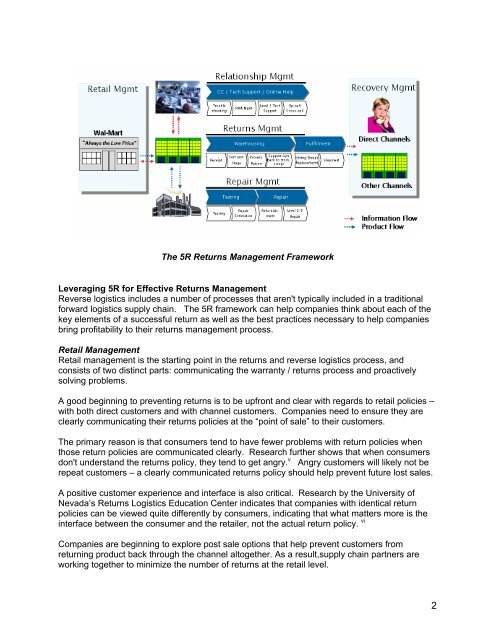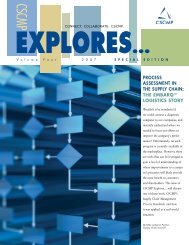Return Profits From Returns: Leveraging all 5 R's - Supply Chain ...
Return Profits From Returns: Leveraging all 5 R's - Supply Chain ...
Return Profits From Returns: Leveraging all 5 R's - Supply Chain ...
Create successful ePaper yourself
Turn your PDF publications into a flip-book with our unique Google optimized e-Paper software.
The 5R <strong>Return</strong>s Management Framework<br />
<strong>Leveraging</strong> 5R for Effective <strong>Return</strong>s Management<br />
Reverse logistics includes a number of processes that aren't typic<strong>all</strong>y included in a traditional<br />
forward logistics supply chain. The 5R framework can help companies think about each of the<br />
key elements of a successful return as well as the best practices necessary to help companies<br />
bring profitability to their returns management process.<br />
Retail Management<br />
Retail management is the starting point in the returns and reverse logistics process, and<br />
consists of two distinct parts: communicating the warranty / returns process and proactively<br />
solving problems.<br />
A good beginning to preventing returns is to be upfront and clear with regards to retail policies –<br />
with both direct customers and with channel customers. Companies need to ensure they are<br />
clearly communicating their returns policies at the “point of sale” to their customers.<br />
The primary reason is that consumers tend to have fewer problems with return policies when<br />
those return policies are communicated clearly. Research further shows that when consumers<br />
don't understand the returns policy, they tend to get angry. v Angry customers will likely not be<br />
repeat customers – a clearly communicated returns policy should help prevent future lost sales.<br />
A positive customer experience and interface is also critical. Research by the University of<br />
Nevada’s <strong>Return</strong>s Logistics Education Center indicates that companies with identical return<br />
policies can be viewed quite differently by consumers, indicating that what matters more is the<br />
interface between the consumer and the retailer, not the actual return policy. vi<br />
Companies are beginning to explore post sale options that help prevent customers from<br />
returning product back through the channel altogether. As a result,supply chain partners are<br />
working together to minimize the number of returns at the retail level.<br />
2




